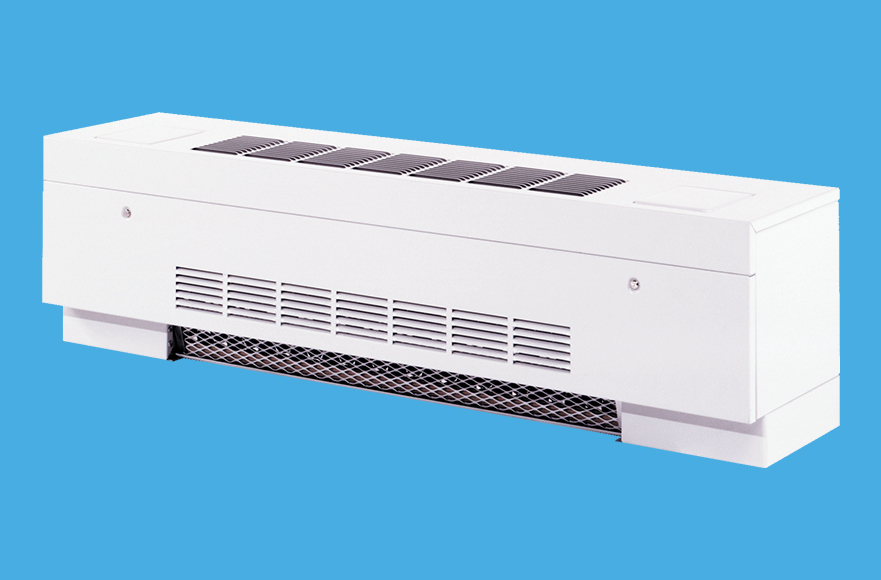FAN COIL UNITS: Are EC Motors Worth the Investment?

Air handling units that include single and double wall air handlers have had energy saving devises available for many decades. First, there was the variable inlet vane which reduced air flow and power consumption during off peak conditions. The latest way is to place a Variable Frequency Drive (VFD) in the unit, which is more efficient than its predecessor, the variable inlet vane. VFD installations are 10 times more prominent than they were just two decades ago. The extra upfront cost of the VFD in a large air handler can be paid off in a year and sometimes even a few months. Of course, these were all “belt driven” units.
But what about direct driven horizontal and vertical fan coil units? Enter the EC motor that’s been around now about 15 years. The formal name is “Electronic Communications Motor” or sometimes referred to simply as “ECM”.
Fan coil units have always been selected by a designer for basically two major reasons. One is it’s primarily the lowest initial cost to cool/heat spaces, and it also allows for individual space and unitary control. This is especially true when there are multiple individual smaller spaces that need to be connected by energy sources (water, refrigerant, electric etc.). These units have been powered by Permanent Split Capacitor (PSC) motors. Each fan coil unit manufacturer normally has an OEM motor manufacturer that builds specific motors for their units. These motors are fractional and usually range from 1/8 hp up to ¾ hp. An EC motor works through an electronic commutation system versus mechanical commutators. This creates a motor that is signaled to produce the least efficient energy required at both full and part load conditions.
Benefits
Here are some of the benefits you will receive from the use of an EC motor versus the standard PSC motor:
- Increased energy efficiency/lower energy bills
- Maximizes CFM air flow for ducted and non-ducted units
- Decrease in blower/motor noise
- Improved air quality
- Better humidity control in conjunction with coil selection
Let’s look at these improvements more closely.
Increased energy efficiency translating to lower energy bills requires the correct selection of fan coil unit and EC motor combination. Efficiency tests show up to 75% improvement versus the old PSC type motor. This can translate into energy bill monetary savings of $75 to $150 per unit each year.
CFM air flow has always been a problem with fan coil units. EC motors maximize the blower’s ability to deliver air flow versus initial static pressure. Over the years, the EC motor may help prevent reduced air flow caused by dirty filters and dirt laden coil cores.
Blower/motor noise is always a problem, because units are close to the occupant’s environment. EC motors are variable speed and are often running at an RPM far below the typical PSC motor application. By the way, this also reduces overall wear and tear and increases motor life expectancy. Simply put, you will not have the motor and blower shutting on and off as much.
You have improved air quality, because the air changes per hour are precise and are based on the most efficient blower/motor combination. Fan coil system design has always had air quality problems due to lack of air flow to specific areas within the space.
Fan coil units have very marginal humidity control because of their standard 3-row coil designs. You can achieve a dry bulb temperature, but the percentage of relative humidity at the thermostat set temperature can be very marginal. Working in conjunction with a very precise air flow that EC delivers at all load conditions will improve that humidity factor. “Comfort” is the combination of delivering a cool temperature with enough moisture removed that one is truly comfortable.
Payback Expectations
Fan Coil units cost a lot less than the industry’s larger air handlers. The cost of an EC upgraded motor can sometimes add 50% to 75% to the cost of the entire unit. Example: Let’s say you can save $75 per year on a 300 CFM horizontal basic fan coil unit that would have cost $300 with a PSC motor but would cost $475 with an ECM motor. The added cost of $175 would be paid back in approximately 2.5 years. The average life expectancy of a fan coil unit is 20 years. This means you would receive costs savings after paying off the EC motor upgrade of $3,062.50 ($175/year for 17 ½ years).
However, there are many other benefits of the EC motor besides energy efficiency and directly related lower energy costs. The air flow quality will be improved and more consistent and there will be less noise. Add in additional comfort through humidity removal, and you can see there’s a lot more to be gained than just payback. At Southwest Coil, we can safely say that any system will benefit greatly from the application of EC motors on fan coil units, and it will be a decision that rewards you in multiple ways for the life of your system.
Southwest Coil exclusively represents USA Coil & Air in the Southwest Region. Our extensive knowledge and experience with coil failures; efficient, quality quotes; variety of expedited shipping schedules; and after-order follow up are the best in the coil replacement market. We’ve built our entire organization on what it takes to satisfy our customers. We invite you to take advantage of our expertise!


